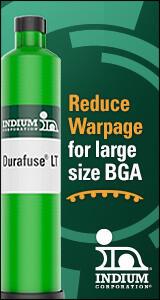|

|
|
| Ask the Experts | |||||||
|
|||||||
|
July 29, 2024 - Updated July 4, 2007 - Originally Posted Remove and replace a 240 pin connectorI have to remove and replace a 240 pin connector from a lead free board with immersion silver plating. Board is 0.125" thick and we use SAC305. Do you have any advice on how to achieve this process without burning the pads off the underside of the board? S.A. |
|||||||
| Expert Panel Responses | |||||||
|
Multip pin connectors can be a bear to remove. I'm sure we would use a solder fountain to tackle such a job. We have a few detailed procedures and articles on our website you may want to look over. See the following. Guide 7.2.2 Soldering Through Hole Components, Solder Fountain Method Feature Articles A Time Saver, But Beware - How to Use a Solder Fountain Multi-Pin Connector Removal and Replacement: Tackling "Goliath"
President Circuit Technology Center, Inc. Mr. Ferry is President of Circuit Technology Center, a world-leading contractor for the repair and rework of assembled circuit boards founded in 1983. Jeff also serves as Publisher of Circuitnet and Semiconductor Packaging News.
I suggest you contact AirVac Engineering on this.
North America Sales Manager Essegi Automation Mr. Black was the President and Co-Founder of Zevatech in 1977 and introduced first Pick and Place System at Nepcon West 1980. Bob is now the President, CEO and Co-Founder of Juki Automation Systems. He is also a Co-Founder of the SMEMA Council of IPC. He serves as a member of SMTA and SEMI..
Most companies use either hot air / solder tip with a vacuum or a solder fountain. The concern is rarely with burning pads and more with copper dissolution. The general experience has been you have approximately 30 seconds of exposure before you dissolve all the copper from the bond pad.
CEO & Managing Partner DfR Solutions Dr. Hillman's specialties include best practices in Design for Reliability, strategies for transitioning to Pb-free, supplier qualification, passive component technology and printed board failure mechanisms.
The key to a job like this one is Pre-Heat. A board of this thickness will just heat sink away any input from an Iron or Rework station unless the entire product is at elevated temperature. Frankly, I am not an expert on Rework so I will let the Rework gurus give you the best approach. But we have seen customers run large product through the Reflow oven to get it up to temperature and then move it to the rework station to remove and replace parts. Don't get the wrong idea. I am not saying that anyone should buy a reflow oven for the purposes of preheating for re-work. The example was to show an extreme case and demonstrate that the entire assembly needs to be up to an elevated temperature to perform the task. Most rework stations will have a preheat option and that is where the real action is. At the end of the day it is all about data. So pull in the Rework vendors, give them a sample board and let them have at it. Most will come running. And those who don't are staying away because they can't help you!
President Heller Industries Inc. Mr. Peo has been with Heller Industries for over 20 years and has been President for the past 8 years. Marc has authored several industry articles on Soldering, Flux collection, nitrogen use and Lead Free conversion.
The advise offered starts with the assumption that the Rework system used is operating properly and capable of Lead-Free processing. That temperature measurements are credible and thermocouples used are properly attached with high temperature thermally conductive adhesive to the sample. That the solder paste supplier's recommended profile, component and substrate manufacturers' thermal limitations are under consideration. If so, then to minimize the thermal impact of the Rework process starts with a preheat cycle from ambient then ramping with a gentle heating rate of about 1 degree per second to attain an overall assembly temperature of no less than 150C. The more uniform the temperature distribution is across the assembly during preheating, the lower the chance that damage will occur due to dissimilar thermal expansion and contraction. The type of heat applied can dramatically impact thermal uniformity across the assembly. Very focused heat applied to the bottom of a Rework site alone may "burn the pads off" in an attempt to elevate the Rework site temperatures above the melting point of the alloy, i.e SAC305 at 221C. This is especially so with heavy mass boards that require significant more energy than nominal size boards with a thickness of 0.062". Once properly preheated, similar Reflow and Cooling ramps should be observed while minimizing the site's overall time above liquidus (TAL) to about 60 seconds or less and overall peak temperature (Tmax) to typically less than 240C. Controlled cooling should continue at similar rates to ensure proper solder interconnect formation and to prevent component and board warpage.
Regional Sales Manager Finetech Al Cabral is Regional Sales Manager for Finetech and Martin rework products. His expertise includes through-hole, surface mount and semiconductor packaging with an emphasis on soldering and heat transfer. Al has been a significant contributor to the development and optimization of reflow and rework processes and systems, particularly lead-free transitions and microelectronic applications.
|
|||||||
| Submit A Comment | |||||||
|
Comments are reviewed prior to posting. You must include your full name to have your comments posted. We will not post your email address. |
|
Free Newsletter Subscription
Circuitnet is built for professionals who bear the responsibility of looking ahead, imagining the future, and preparing for it. Insert Your Email Address |
|

|







